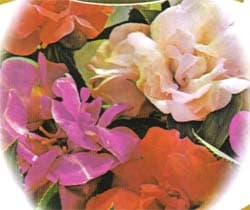How to Grow Balsam Flower

Growing Balsam Flower in Your Home Flower Garden
Growing Balsam flowers is easy. Native to Asia, Balsam is a Victorian garden favorite. It is a quick-growing summer annual flower, with gardenia-like blooms. With a little care, the plant is an all-season bloomer. With good weather and rich soil, it will display the first flowers in as little as sixty days from planting them.Continuous blooms grow on top of a bushy plant with glossy leaves. Balsam is a member of the Impatiens family. Colors include shades of white, pink, rose, violet, and red. Balsam are native to Asia, North America, and South Africa. There are annual and perennial varieties.
Balsam is often grown in containers on balconies and terraces. Use large pots to provide plenty of space for them. Balsam also is a good bedding or edging plant.
Balsam Flower Plant Specifications
Flower Colors: Pink, purple, red, white, and bi-colors.
Days to Bloom: You will get blooms in about 60-70 days.
Flowers Bloom: Long flowering, from summer through fall.
Plant Height: 14″ – 20″
Ideal Soil pH: 6.0 – 6.5
Light Requirements: Grow in full to partial sun.
Hardiness Zones: 2 – 11
Native To: Asia
Toxicity: Mildly toxic if ingested in large quantities. We recommend you keep this plant away from children and pets.
Other Names: Rose Balsam
Annual, Impatiens, Balsamina
Are Balsam Flower Plants Edible?
Yes and No!
The stems and leaves are mildly toxic and should not be eaten. Keep the plant away from children and pets.
The Balsam seed and flowers are non-toxic. While they can be eaten, few people consume them.
Medicinal Benefits of Balsam Flower
Herbalists know of a variety of medicinal uses for this plant.
- Among them are:
- It is used for skin afflictions.
- The juice of the leaves treats snake bites. Apply the flowers to burns for soothing relief.
- In Nepal, the leaves are crushed and used to dye fingernails.
Balsam Flower Plant Propagation
Balsam flowers are grown from seed. They can be directly seeded into your flower garden or seeded indoors in trays or flats for transplanting later. Sow indoor starts about six to eight weeks before the last frost. Keep soil moist while germinating.
Sow balsam seeds early in the season, and cover with 1/8″ of soil. Water thoroughly. It is important to keep the soil moist during the germination period.
Also, you can root cuttings. They root quickly. Then you can plant them into flowerpots for your patio or deck.
Balsam will begin to produce a continuous, profusion of flowers by early to mid-summer, and all the way to frost.
Days to Germination: 10 – 15 days.
How to Grow Balsam Flower Plants
Balsam likes full to partial sun. Shade the plants from the afternoon sun, especially in hot regions. If it gets too little sunlight, flowers will be sparse and small. This annual plant is an excellent re-seeder. So, pick a garden location where it can grow undisturbed for many years.
They prefer rich, well-drained organic soil. Before planting them for the first time, mix a generous amount of compost into the planting site. Then, later in the season, apply an organic mulch or compost around the plants. This will help to make them look their best and help to keep the soil moist. As the material breaksdown, it also feeds the plants.
Space plants 12-18 inches apart.
Water them during dry periods, once or twice per week. Don’t allow the roots to remain wet.
Add a general-purpose fertilizer regularly for optimum growth. We recommend a slow-release formula. And, follow the directions on the fertilizer package.
When the plant has grown to four to six inches tall, pinch back the growing tips. The results in a bushier, more attractive looking plant.
Once established, Balsam will grow well and bloom continuously well into fall. Annual varieties are susceptible to frost. Frost kills these tender plants.
Should I Prune My Balsam Flower Plants?
These annual flowers do not require pruning. However, if there are dead or sick leaves, they should be removed back to the main branch or stem.
An occasional rogue branch can be pruned to help maintain the shape of the plant.
Deadheading spent blooms encourages the plant to produce more flower buds. How to Deadhead spent blooms.
Insects and Plant Disease
If insect or disease problems occur, treat early with organic or chemical insect repellents and fungicides.
Downy mildew can be a problem. There is no treatment for it. If your plant has it, pull the plant and put it in the trash. If you are unsure, throw the plat away. Do not put it into your compost pile.
Also see: Plant Problems – causes and cures.
Please support our site. Shop for:
- rmmatthews100@hotmail.com
- 585-721-6528
- Rochester, NY
©1999-2024 GardenersNet.Com, All Rights Reserved

